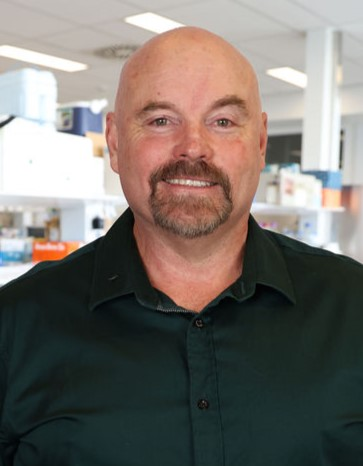
Dr Wayne Hawthorne is Professor of Transplantation at the Department of Surgery, The University of Sydney, and is the Director of the National Pancreas and Islet Transplant Laboratories, at Westmead Hospital, Westmead.
He is the Immediate Past President of the International Xenotransplantation Association (IXA), the current President of the Australasian College of Biomedical Sciences (ACBMS), Chairman of the Xenotransplantation Working Group of The Transplantation Society of Australia and New Zealand (TSANZ) and Chairman of the Western Sydney Local Health District Animal Ethics Committee (WSLHD AEC).
Professor Hawthorne’s career has focused on treatments for Type 1 Diabetes (T1D), having established the laboratory and techniques to perform islet cell isolation for Australia's First Clinical Islet Transplant program. Paralleling the clinical program Professor Hawthorne has dedicated his research career to establishing Australia’s Islet Cell and Xenotransplantation research programs, obtaining ongoing NH&MRC and JDRF grants for more than 25 years. He developed and has established the Westmead non-human-primate (NHP) facility and has extensive small and large animal surgical and anaesthetic expertise that few others have in Australia. He has decades of expertise in large animal models, including the use of NHP’s in research. He continues to oversee the islet and xenotransplant research programs at the Westmead facility and remains dedicated to continuing to develop and provide the most Ethical and humane ways to run medical research projects and ensure their translation to the clinic along with the training of many scientists, clinicians and surgeons.
A founding researcher of the Centre for Transplant and Renal Research at the Westmead Institute for Medical Research and The University of Sydney, he remains responsible for surgical research projects where he has supervised many students including; PhD, Masters, Hons and MD students. He continues to build on the success of his research work and his team have translated the transplantation treatments for T1D, being the first in Australia to perform both Clinical Allo and Auto islet cell isolation and transplantation and to perform islet after kidney and combined islet/kidney transplants into clinical patients. He has performed more than 330 clinical islet isolations and islet cell transplants in both adults and children as young as 4 years of age. He has >250 journal publications, 20 books and book chapters and >700 published proceedings along with presenting numerous International and National presentations.
Advancing cures for type 1 diabetes using flow cytometry as a guide for safe and efficacious immunosuppression in xenotransplantation
Wayne Hawthorne1,2, Thanh Le2, Evelyn Salvaris3, Erin Fuller2, Mark B Nottle4, Peter J Cowan3,5.
1Department of Surgery, Westmead Hospital, University of Sydney, Westmead, Australia; 2Translational Transplantation Therapies Program, Westmead Institute for Medical Research, Westmead, Australia; 3Immunology Research Centre, St. Vincent’s Hospital Melbourne, Melbourne, Australia; 4Reproductive Biotechnology Group, Robinson Research Institute and School of Biomedicine, University of Adelaide, Adelaide, Australia; 5Department of Medicine, University of Melbourne, Melbourne, Australia
Background: Islet xenotransplantation is a promising alternative to allo-islet transplantation to treat Type1 Diabetes. Despite significant advances in transgenic pigs, we still require heavy immunosuppression to prevent rejection. To optimise immunosuppressive protocols, we require a means to more regularly monitor the efficiency of immunosuppression on recipients and prevent graft rejection. Here we present our analysis of the development of a more predictive and more regularly performable method.
Methods: Porcine neonatal islet cell clusters (NICC) from GTKO-hCD55-hCD59 transgenic pigs were transplanted into STZ induced diabetic baboons (n=9). All received anti-CD2 antibody (Abs), tacrolimus, anti-CD154 Ab and Belatacept immunosuppression. Blood samples were collected from recipients before and after transplantation from which counts of blood leukocyte subtypes were monitored using multiplex, multi-panel flow cytometry (Flow). NICC function was assessed by multiple daily blood sugar levels (BSL) and monthly glucose tolerance tests. Additionally, NICC xenograft maturation and function were assessed histologically from biopsies with immune-profiling of NICC graft sites analysed by multiplex immunofluorescence staining of the 4 months-post transplant biopsy and endpoint tissue collection.
Results: All diabetic baboons (n=9) were transplanted with GTKO-hCD55-hCD59 transgenic pig NICC’s and were followed to end point following withdrawal of all exogenous immunosuppression. All grafts demonstrated function and provided normoglycaemia in all animals. Systemic porcine C-peptide was detected from day 30 onwards. Day 120 liver biopsies showed well preserved morphology with no cellular infiltrate and positive staining for insulin, somatostatin and glucagon (n=7). Flow using IVD BD true count produced equivalent cell counts compared to standard full blood count (FBC) test demonstrated by Deming regression analysis (95% CI slope = 0.91-1.031, p<0.001). Noticeably, cell count by Flow were completed faster (50 minutes ± 15 versus 150 mins ± 30 for FBC test) and used significantly smaller sample volume (standard 50 µl versus 500 ±50 µl blood for FBC test). Using Abs targeting specific markers for different lymphocytes subtypes, the Flow method provided more sensitivity and specificity in real-time monitoring blood immune profiles in xeno-islets recipients. Flow data showed specific T cell-binding and suppression of anti-CD2 Abs with reduction of unoccupied surface CD2 on T cells in recipient’s blood after anti-CD2 Abs treatment (mean of 73.21 %, 55.26% -91.16%, p <0.001). Long-term NICC survival (n=7) showed significant T cell suppression during the first month post-transplant (36.47%, 13.35-50.75 %) compared to short-term NICC survival (n=2) (176.28%, 171.26 – 181.31 %). Early elevated blood lymphocyte levels (40 -142 %) were also detected in the two recipients that lost NICC function shortly after the withdrawal of immunosuppression. Qualitative analysis of endpoint NICC grafts by multiplex immunofluorescence demonstrated NICC destruction through cell-mediated killing with increased lymphocyte infiltration and cytotoxic CD8+T cell activation.
Conclusion: This study demonstrates the utility and reliability of Flow to be a more helpful tool to study immune status of xeno-islet recipients. It is significantly faster to perform than standard FBC, utilising a much smaller sample allowing for more regular and easily obtainable samples from bottom pricks rather than formal blood collection.
Breakthrough T1D . National Health and Medical Research Council, Australia.
[1] Xenograft
[2] Flow Cytometry
[3] Islet Xenotransplantation
[4] Diabetes
[5] Immune profiling
